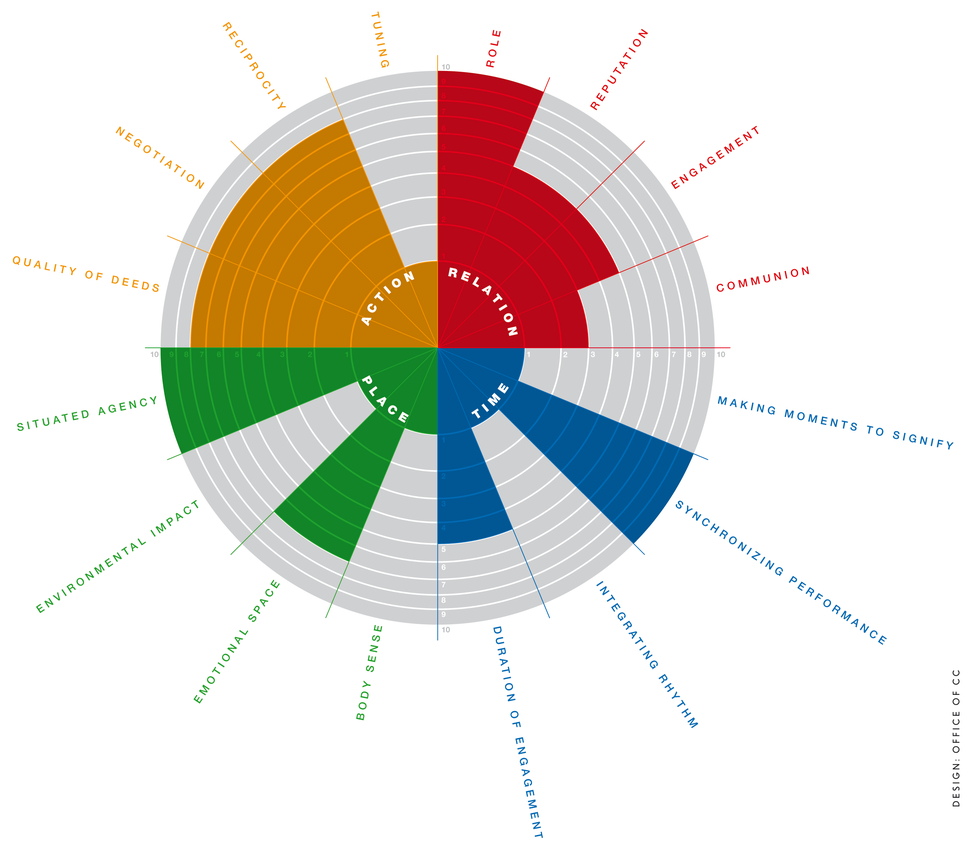Relation: Experts in the Crime Scene Investigation of the CSI The Hague project meet each other in professional roles. This defines their engagement and affects their reputation. Interestingly, the experts in this case need to create a shared meaning. Not the same type of shared meaning as the shared meaning we make with family or friends, but a shared meaning to contextualize and understand a crime scene investigation that also includes ethical positions in the process.
Time: Experts work together for the limited amount of time that is needed to do the investigation. They are trained in their professional roles to synchronize performance. This is not often possible as their rhythms will often not be integrated as they have different professional environments and may even live in different time zones. Because they work online in mediated presence, it is almost impossible to share moments that signify. It is almost impossible to share celebration when successful or share the mourning that comes with atrocity or defeat. On the time dimension the performance of presence is defined by the lack of trust caused by a low integration of rhythms and not-sharing of moments to signify.
Place: The body sense and environmental impact between an expert on the crime scene and an expert elsewhere is very different and therefore contribute very little to the collaborative performance of presence. The emotional space experts share, depends significantly on the compassion and experience of the remote expert. This emotional space is defined by professional roles, expert knowledge of the task at hand, but also by the gravity of the situation with which both experts have to deal. Situated agency, the fourth factor in the place dimension, is clearly defined as a requirement. The purpose of the application is to give agency to the remote expert to make remote collaboration effective, which if successful, will significantly contribute to experts trust in the situation.
Action: Reciprocity in signs and negotiation of conditions are performed in professional settings and can be executed in remote situations as well. However, these are hindered by the lack of tuning possibilities. No body moves or breath space can be shared. Trust in the expert collaboration may be created by a series of activities for contextualizing the actions experts may exchange at distinct moments in time.
Overall the YUTPA analysis shows that the degree of trust in the expert in augmented collaboration is a challenge. Of the 16 factors that have been identified so far, only 7 contribute significantly to trust affecting choices and trade-offs for presence in the current design. Synchronizing performance, situated agency, reciprocity, negotiation, quality of deeds and role are requirements on which the design of the system it is based. Depending on the experts that engage with each other, emotional space and communion may contribute to the degree of trust in augmented collaboration in which case the balance flips to more than half of the factors contributing to trusting mediated collaboration. But these are highly individual factors. From a presence design perspective the system could benefit from the time dimension by enhancing, for example ‘integrating rhythm’. In the place dimension situated agency and emotional space could benefit from explicit functionality designed to this purpose. In the action dimension, there are options to improve tuning of presence and quality of deeds. In the relation dimension a reputation system may contribute to the sense of presence.
